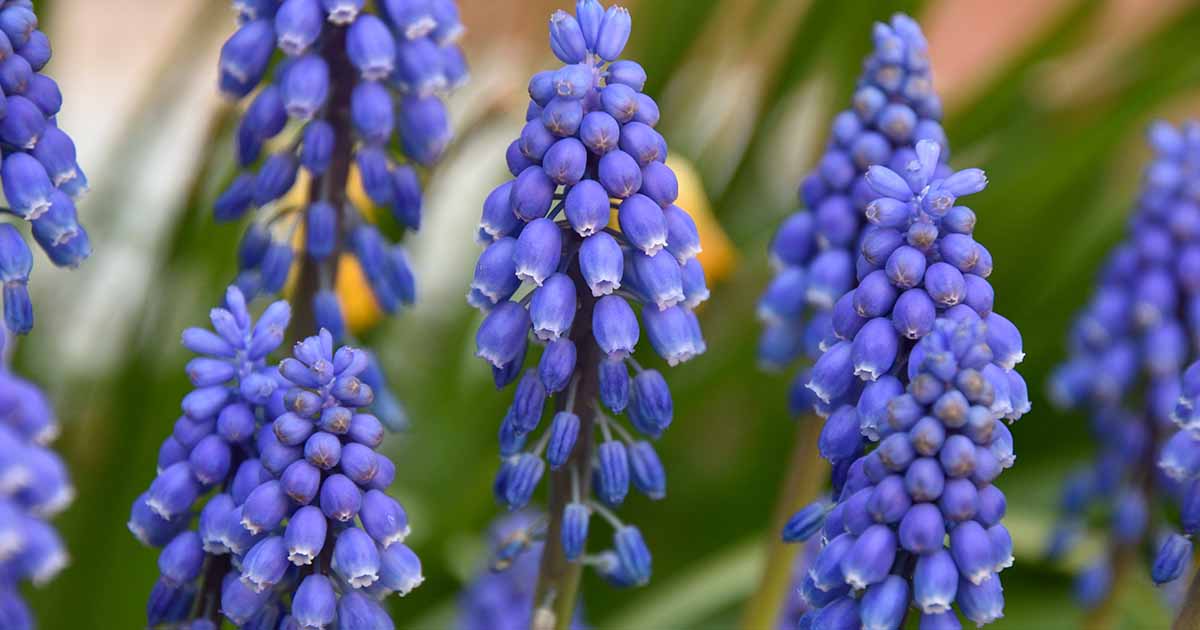Grape hyacinth (Muscari spp.) is the queen of easygoing, bold, beautiful spring color.
After you plant the bulbs you can pretty much forget about them, except when you’re enjoying the blooms, of course.
But once the flowers start to fade, the plants can look a bit ragged. Removing the spent blossoms will not only tidy up the garden, it’s actually beneficial for the plant as well.


We link to vendors to help you find relevant products. If you buy from one of our links, we may earn a commission.
In our guide to growing grape hyacinth, we discuss how to cultivate these gorgeous flowers in your landscape.
This article concentrates on what to do with the plants after blooming to promote the happiest, healthiest, and best looking plants.
Here’s what we’ll talk about:
Grape hyacinth blooms in the spring. After a few weeks, the flowers fade, leaving just the foliage in place.
As a few more weeks pass, the leaves start to fade, as well.


This is all totally normal for Muscari. You don’t have to do anything to the plants if you don’t want to, as they’ll generally return year after year.
We gardeners can step in and do some tidying up to improve the plant’s health, limit its spread, and encourage larger blossoms.
In addition to pruning, the amount of food and water that you provide to your plants is also important. Let’s look at moisture needs, first.
Water Needs
When grape hyacinth flowers start to fade, the plant doesn’t need nearly as much moisture as it did when it was in full bloom, as preparing for dormancy doesn’t require much energy.


Wait until the top two or three inches of soil has dried out before you water. When the leaves die back, you don’t need to worry about watering at all.
Just use your finger to test the soil moisture or, if your soil is heavy and dense like mine is, you might be better off using a moisture meter instead.
Fertilizer
Giving the grape hyacinths some bone meal after the flowers fade is a good idea. Bone meal contains magnesium, zinc, phosphorus, and nitrogen.
These are all nutrients that are necessary to promote abundant blooming – and the nutrients depleted from the soil as the plants grow and flower.


Depending on the manufacturer, bone meal typically has an NPK ratio of around 3-15-0. That means it has three parts nitrogen and 15 parts phosphorus but no potassium.
Nitrogen, phosphorus, and potassium are considered the three major macronutrients.
Flowering plants generally need quite a lot of phosphorus to help them bloom abundantly. Foliage plants need extra nitrogen.
Deciding what to feed your plants will depend on the nutrient composition of your soil.
For example, on my property in the lush Tualatin Valley of Oregon, the soil is generally high in nitrogen, potassium, and phosphorus.
I live in a valley that is primarily made up of silty, loamy soil from glacial deposits and volcanic ash, with a dash of forest loam. That means it’s pretty organically-rich to begin with.
So when I test my soil, I generally only need to add nitrogen, as that’s the nutrient that comes out a bit on the low end.
Other gardeners might have sandy soil that was created from ocean deposits or lake sediment.
These tend to be naturally nutrient-depleted, so in these areas you’ll need to fertilize more often and with a more complete fertilizer than I would need.
So assuming you either haven’t tested or your soil is not deficient, bone meal is the ideal fertilizer to give your grape hyacinths a boost after flowering.


Bone Meal
Down to Earth makes an all-natural bone meal in five-pound compostable boxes. Grab some at Arbico Organics.
Pruning
Pruning is a key part of grape hyacinth care. Go ahead and snip off the flower heads after they have faded.
Spent flowers can be a drain on the plant’s energy, unless of course you want them to produce seeds.


Grab some pruners or scissors and cut the flower stalk as low and close to the base of the plant as you can without disturbing the foliage.
Don’t prune the foliage. As long as it’s green and firm, it’s still working to provide nutrients to the bulb for its long dormant season.
When the foliage is shriveled and yellow, you can prune it off.
I know it’s tempting to just give the entire plant a haircut, but this will reduce the lifespan of the bulb and can impact the size of the flowers.
If you want to allow the plants to self-seed, wait until most of the blossoms have turned to seed and then snip away the remaining stalks.
Indoor Plants
If you kept your plants indoors and forced them to bloom for a pretty spring display, you can either toss the bulbs when they’re finished blooming or plant them outside.


They won’t bloom a second time indoors.
If you plan to keep them for planting out, wait until the blooms have faded and cut the flowering stalks down to the base.
When the foliage turns yellow and goes floppy, dig up the bulb and replant it outdoors.
Alternatively you can brush off the soil, place it in straw or newspaper, and set it in a cardboard box to store it until the next year.
Keep the box in a cool, dark spot.
Keep Your Muscari Happy
I welcome grape hyacinth wherever it grows. It’s welcome in my lawn and in my gardens, because the early color is pretty hard to beat.
The fact that the plants are pretty darn easy to care for, even after flowering, is just a bonus.


What do you love about Muscari? How do you deal with them after they’ve flowered? Let us know in the comments section below!
And for more information about growing grape hyacinth in your landscape, read these guides next:


